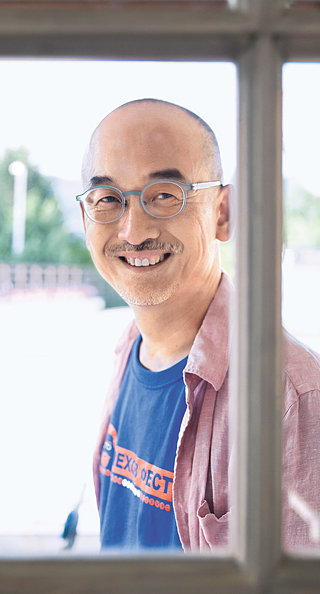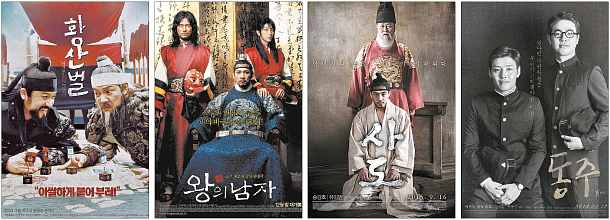Turning to history to find compelling characters : Director Lee Joon-ik tells the riveting story of Park Yeol in ‘Anarchist from Colony’
Published: 10 Jul. 2017, 21:07

Prolific director Lee Joon-ik, 58, is back with another historical drama, “Anarchist from Colony” starring Lee Je-hoon and Choi Hee-seo. [JEON HO-SUNG]
In an interview with the JoongAng Sunday, an affiliate of the Korea JoongAng Daily, Lee revealed that what drew him to the photo was the man’s posture; he was instantly curious as to how a man who was being investigated for attempting to murder the Crown Prince of Japan could be sitting in such a way. Lee said that he always wondered what the man in the photo was thinking or what his facial expression is trying to say. Lee’s movie, “Anarchist from Colony,” was the way for Lee to explore his curiosity.
This biographical drama follows the life of Korean anarchist Park Yeol, (1902-74,) who led an anarchist group called Bulryeongsa after his arrival in Tokyo in 1919. This film also features Park’s Japanese partner Kaneko Fumiko, (1903-26,) who was sentenced to death along with Park in Japan. After 2015’s “Dongju; The Portrait of A Poet,” this is Lee’s second film about Japanese colonization.
The film is set in 1923, when the Great Kanto Earthquake hit Japan, which resulted in the killing of 6,000 innocent Koreans after false rumors were spread that they were trying to take advantage of the Japanese in the post-quake havoc. To divert attention from the murders, the Japanese cabinet indicted Park for his involvement in Bulryeongsa. Park was sentenced to death in 1926, but after the ruling drew international attention, it was reduced to life in prison. Kaneko died that year at a jail in Japan, and Park stayed in that jail for 22 years, until 1945. Below are the edited excerpts from the interview with director Lee.

A photo of Park Yeol, left, with his Japanese lover Kaneko Fumiko, while on trial in 1925. At right is the movie poster of Lee Joon-ik’s 2017 film “Anarchist from Colony,” starring Lee Je-hoon, left, and Choi Hee-seo. [MEGABOX PLUS M]
A. About 90 percent of the movie is based on the truth, gathered from historical research. Along with a critical biography about the life of Kaneko Fumiko, I went through about 100 books, and also looked through newspaper articles related to her and Park’s trial. In the movie, there are multiple scenes where the Japanese cabinet is holding a meeting, and the characters in that scene are real life people, and what they say is based off of actual records.
Is there a reason why you chose to look through the historical records so closely?
Think about it. This incident took place in Tokyo. The trial of Park and Fumiko, who were imprisoned under the charge of attempting to murder the Crown prince, was covered in Japanese newspapers. Park and Kaneko must have been the most troublesome prisoners for the Japanese. For instance, Park appears in court wearing a purple robe which is usually worn only on special occasions, like weddings. If a Japanese person sees this film, they may wonder if this incident really took place, but once people look into the incident, they will realize it is the truth.
The photo of Park and Kaneko at their trial is shocking.
I think this photo tells everything about the film. Park and Kaneko were anarchists who denied the powers that oppressed their personal freedom. And instead of being sentenced to death, it was more like their death sentence was an accomplishment. This photo is making fun of Japan’s judicial system as the country was trying its best to be acknowledged as a constitutional nation in the international community.
The movie is based on a tragic truth, but it is rather upbeat.
I did not intend to make it upbeat; rather I just referred to historical records. Anarchists at that time had the tendency to do whatever they desired out of the fear of dying the next day.
Why do you think not many people remember Park’s life?
Under the ideology of the Cold War, anarchists were treated like communists. History is restricted under the frame of those who were in power. As seen in the relationship between Park and Kaneko, anarchists during the Japanese colonization period were the ones who accepted and embraced modernity. After Park went to North Korea, he still worked actively and then faded away.

From left are director Lee Joon-ik’s films “Once Upon A Time In The Battlefield,” (2003), “King And The Clown,” (2005), “The Throne,” (2014) and lastly “Dongju; The Portrait of A Poet.” (2015) [MEGABOX PLUS M]
I always had it in my mind, but I did not have a definite standard as to how I should view Japanese colonization. I think I gained confidence when I produced the film “Dongju; The Portrait of a Poet.” When making the film “Dongju,” I wanted to looked into the logic of Japanese imperialism and how that logic was fabricated, by having the scene when the Japanese detectives are interrogating Dongju and his friend. I hope Koreans broaden their scope regarding Japanese colonization after watching this film.
Was history your favorite subject when you were in school?
No. I was not the brightest kid in class, and I was far from a book worm. It was when I started to make movies that I got interested in history. I think time constantly continues and players are the ones who change. Therefore, similar incidents occur again. I think the secret key to my movies is what points I highlight from a specific historical event.
Do you plan to make a trilogy on the Japanese colonization?
Life doesn’t go as one plans, so I don’t have specific plans. But as I study Japanese colonization, I am drawn to the Korean independence movement. This movement was also internationally recognized, but there is not a movie dedicated to this feat. I am not saying that I am going to do a movie about it... I am just saying [that there’s a story to be told.]
BY LEE YOUNG-HEE [jeon.sohyun@joongang.co.kr]
“일제 조롱한 한 장의 사진이 영화의 모든 것 말하죠”
한 장의 흑백 사진이 있다. 기모노 차림의 여자가 책을 들고 남자에 기대 앉아 있고, 남자는 왼손을 여자의 가슴 쪽에 올린 채 옅은 미소를 띠고 카메라를 바라본다. 2000년, 영화 ‘아나키스트’를 준비하던 이준익(58) 감독은 일제 강점기 조선인 아나키스트들의 이야기를 읽다 ‘박열’이라는 이름과 함께 실린 이 사진을 발견했다. “1925년 황태자 암살 기도 혐의로 일본 재판소에서 조사를 받던 중 찍은 사진이라는 데, 어떻게 저런 포즈가 가능했나 궁금했어요. 무슨 의도였지? 저 표정은 무슨 이야기를 하고 싶은 거지? 그 궁금증이 계속 마음에 남아있었죠.”
지난달 28일 개봉한 영화 ‘박열’은 이 궁금증을 푸는 의식이었다. 영화는 1919년 3·1운동 직후 일본 도쿄로 건너가 아나키스트 단체 ‘불령사’를 이끌었던 독립운동가 박열(1902~1974)의 삶을 다룬다. 박열과 함께 일본 법정에서 사형 선고를 받았던 동지이자 연인 가네코 후미코(金子文子·1903~1926)의 이야기 역시 비중 있게 그려진다. 이 감독이 지난해 ‘동주’에 이어 두 번째로 돌아보는 일제 강점기 역사다. 지난 22일 개봉을 앞둔 이준익 감독을 서울 삼청동 카페에서 만났다.
영화 ‘박열’은 자신감 넘치는 자막과 함께 시작한다. “이 영화는 고증에 충실한 실화입니다. 등장인물은 모두 실존 인물입니다.”
배경은 1923년 일본에서 일어난 간토대지진. 당시 “조선인이 우물에 독을 탔다”는 괴소문이 퍼지면서 불과 3일간 죄 없는 조선인 6000여 명이 학살된다. 일본 내각은 조선인 학살에 대한 명분을 찾던 중 항일단체 ‘불령사’를 이끌던 조선 젊은이 박열을 대역 사건의 배후로 지목한다.
질의 : 정말 거의 실화인가.
응답 : “90% 이상이 고증을 거친 사실이다. 일본 연구자 야마다 쇼지가 쓴 평전 『가네코 후미코』를 비롯해 관련 서적 100여권, 박열과 후미코의 재판을 보도한 아사히·산케이 신문 등의 기사까지 샅샅이 뒤져가며 작업했다. 일본 내각의 회의 장면이 여러 번 나오는데, 거기에 참석한 인물들 역시 모두 실존 인물이고, 그들이 나누는 대화도 일부는 기록으로 남아있는 그대로다.”
질의 : 그렇게까지 철저히 고증해야 했던 이유는.
응답 : “생각해보라. 일본의 수도 도쿄에서 일어난 사건이다. 황태자 암살 시도 혐의로 투옥된 박열과 후미코의 재판 과정은 일본 신문에 낱낱이 보도됐다. 이들은 아마 일본 역사상 가장 골치 아프고 버릇 없는 피고인들이었을 것이다. 예를 들어 박열은 조선인의 정신을 보여준다며 보라색 사모관대(紗帽冠帶) 차림으로 법정에 나온다. 만약 일본인들이 이 영화를 본다면 ‘저게 말이 돼?’라고 생각하겠지. 하지만 구글 검색만 해봐도 곧 전부 사실임을 알게 될 거다.”
질의 : 두 사람이 재판소에서 다정하게 찍은 사진 역시 충격적이다.
응답 : “이 사진이 영화의 모든 것을 말해준다고도 생각한다. 박열과 후미코는 개인의 자유를 억압하는 모든 권력을 거부하는 아나키스트들이었고, 사실상 사형 선고를 받았다기보다 사형 선고를 ‘쟁취’했다. 이 사진 역시 당시 국제사회에 ‘법치주의 국가’로 인정받고자 발버둥 치던 일본 정부의 사법 체계를 대놓고 조롱하는 사진이었다. 윤동주·송몽규와는 또 다른 방식으로 자신의 신념을 지키기 위해 젊음을 통째로 바친 이들인 것이다.”
신념 위해 청춘 바친 아나키스트들
일본 정부는 1926년 3월 이들에게 사형 판결을 내리지만, 국제 사회의 관심이 집중되자 곧 무기징역으로 감형한다. “누가 나의 형을 낮출 권리를 천황에게 주었느냐”고 분개하던 후미코는 그 해 7월 우쓰노미야 형무소에서 사망했고, 박열은 1945년까지 22년 2개월 간 형무소 생활을 한다. 출소 후 독립한 대한민국에서 영웅 대접을 받았던 박열 열사는 한국전쟁 발발 후 납북되면서 한국에서 잊혀진 존재가 됐다.
질의 : 비극적인 역사지만, 영화는 무척 유쾌하다.
응답 : “의도적으로 밝게 만든 게 아니라 실제 기록들이 그렇다. 님 웨일스가 쓴 『아리랑』을 보면 당대 아나키스트들에게는 낭만과 허무, 멋이 있었다. 내일 죽을 수도 있으니 오늘은 할 수 있는 걸 즐겁게 한다는 태도다. 박열이 ‘청년 조선’이라는 잡지에 쓴 ‘나는 개새끼로소이다’라는 시를 보라. 자조와 익살로 권력을 조롱하는 태도에서 조선 시대의 해학성을 떠올렸다. 내 영화 ‘왕의 남자’에서 광대 장생과 같은 모습이라고 할까.”
질의 : 하지만 그를 기억하는 한국인은 많지 않다.
응답 : “냉전 이데올로기 하에서 아나키스트는 ‘빨갱이’로 여겨졌다. 권력자들의 프레임 안에 역사가 갇혀 버린 셈이다. 박열과 후미코의 동등한 관계에서도 보여지듯, 일제 강점기의 아나키스트들은 ‘근대성’을 앞서 받아들이고 이를 삶에서 실천한 인물들이기도 했다. 박열은 북으로 간 후에도 활발한 활동을 하다 서서히 기록에서 사라진다. 먼 훗날 이준익이 이들을 찾아낼 지는 아무도 몰랐겠지.”
질의 : 왜 뒤늦게 영화를 만들었나.
응답 : “생각은 늘 있었지만, 일제 강점기를 어떻게 바라봐야 할 지에 대해 나 스스로 명확한 기준이 없었다. ‘동주’를 만들면서 조금 자신감이 생긴 것 같다. ‘동주’에서는 일본 형사와 동주·몽규의 심문 과정을 보여주면서 일본 제국주의의 논리를 깊이 들여다보고, 그 논리의 허구성을 파헤치고 싶었다. 이번엔 피식민지 아나키스트들의 목소리를 통해 들어보는 일본 제국주의의 모순이다. 이 영화로 한국 사람들이 일제 강점기를 바라보는 시각이 조금 더 넓어지기를 기대한다.”
과거에서 현재의 아젠다를 포착하는 게 재미
‘황산벌’(2003)‘왕의 남자’(2005) ‘평양성’(2010)에서 ‘사도’(2015)와 ‘동주’(2016)에 이르기까지, 이준익 감독의 필모그래피에 뚜렷한 존재감을 발휘하는 작품은 주로 역사를 소재로 한 시대극이다. 이 감독은 “어떤 주제를 부각시키기 위해 역사를 끌어오는 것이 아니라, 과거의 이야기에서 현재 우리 사회의 문제나 아젠다를 포착할 때 이를 영화로 만들고 싶어지는 것”이라고 했다.
질의 : 학창 시절에 역사를 아주 좋아했을 것 같다.
응답 : “그럴 리가. 60명 중 50등 하는 아이였고 책과는 전혀 친하지 않았다. 영화를 만들면서 먹고 살기 위해 고전이나 역사를 공부한 거다. 사실 시간은 과거-현재-미래로 계속 이어질 뿐이고 그 위에서 활동하는 플레이어들만 바뀌는 거다. 그러니 당연히 비슷한 일들이 일어난다. 예를 들어 ‘사도’에서는 지금 우리의 큰 문제이기도 한 세대 갈등이 극명하게 드러나지 않나. 하나의 역사적 사건에서 무엇을 어떻게 끌어내느냐는 ‘영업 비밀’이니까 묻지 마시고(웃음).”
질의 : 일제 강점기 3부작을 완성할 계획인가.
응답 : “인생이 구상한 대로 흘러가는 게 아니기 때문에 아직은 아무 계획이 없다. 단 일제 강점기를 파고들수록 3·1 운동과 자꾸 마주치게 된다. 세계사적으로도 엄청난 의미가 있는 저항 운동이었는데, 한 번도 제대로 영화로 만들어진 적이 없지 않나. 내가 만들겠다는 게 아니라 그냥 그렇다는 얘기다.”
이영희 기자










with the Korea JoongAng Daily
To write comments, please log in to one of the accounts.
Standards Board Policy (0/250자)